If you’ve noticed strange holes in your leaves or spots on your plants, you’re likely dealing with some unwanted garden visitors. Garden pests can transform your thriving plants into struggling specimens within days, often leaving behind distinct calling cards that help identify the culprits. Understanding these telltale signs, from sticky residue to lace-like patterns, will equip you with the knowledge to protect your garden before significant damage occurs.
Contents
- 1 Aphid Infestation on Roses
- 2 Cabbage Butterflies on Vegetables
- 3 Japanese Beetles on Trees
- 4 Spider Mites on Houseplants
- 5 Snails on Leafy Greens
- 6 Tomato Hornworms on Nightshades
- 7 Cutworms on Young Seedlings
- 8 Whiteflies on Ornamental Flowers
- 9 Squash Bugs on Pumpkin Vines
- 10 Earwigs on Strawberry Plants
Aphid Infestation on Roses
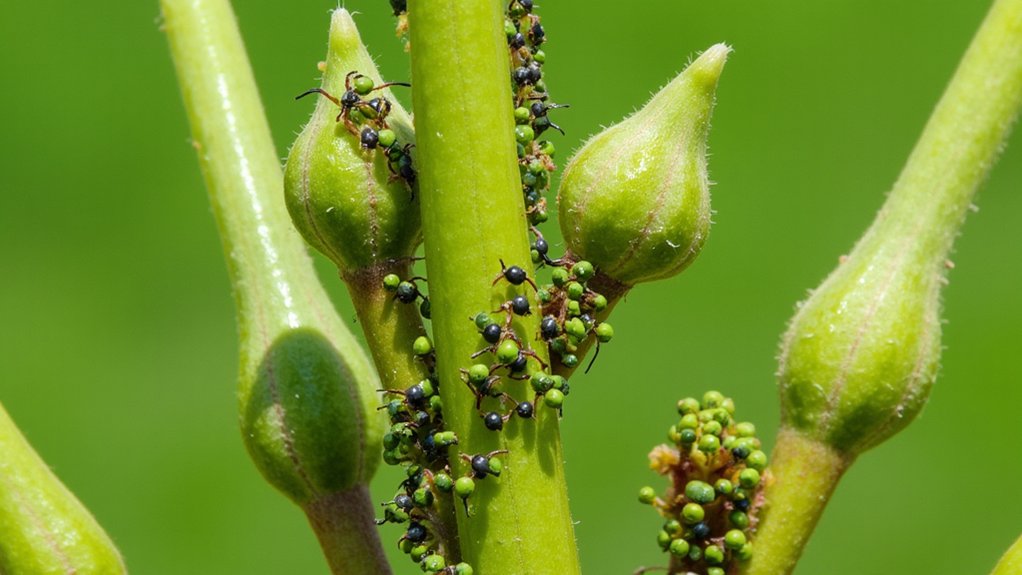
While roses can bring stunning beauty to your garden, these beloved plants often fall victim to aphid infestations during the growing season. You’ll notice these tiny pests, typically 1/8 inch long, clustered on new growth, buds, and the undersides of leaves, where they’ll appear in colors ranging from green to black.
If you’re inspecting your roses, look for sticky residue called honeydew, which aphids excrete as they feed. You’ll also spot yellowing leaves, distorted growth, and sooty mold that develops on the honeydew coating.
These sap-sucking insects reproduce rapidly, with females producing up to 12 offspring daily. They’re most active when temperatures hover between 65-80°F, and you’ll typically spot your first aphid colonies in early spring, just as your roses begin producing tender new growth.
Cabbage Butterflies on Vegetables
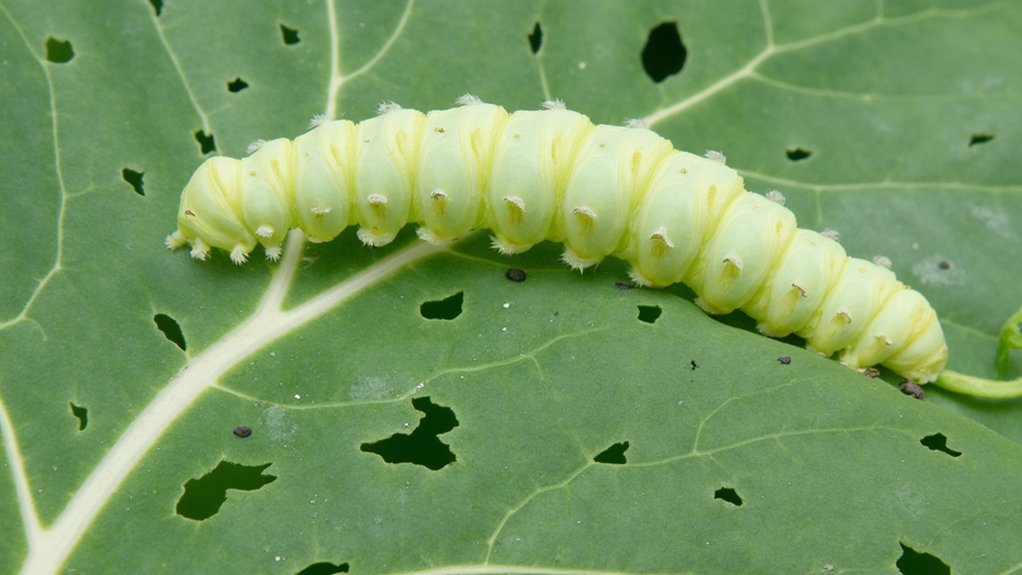
Three common species of cabbage butterflies can wreak havoc on your vegetable garden, particularly targeting plants in the Brassica family. You’ll spot these white butterflies fluttering around your cabbages, broccoli, and kale from early spring through late fall, laying their eggs on the undersides of leaves.
The eggs are tiny, yellow, and bullet-shaped, hatching within 4-8 days into small green caterpillars. These hungry pests will chew irregular holes through leaves, potentially destroying your crop if left unchecked.
You can identify butterfly damage by looking for ragged holes in leaves and spotting their droppings, which look like dark green pellets on the plants. The caterpillars grow to about 1-inch long and have a faint yellow stripe down their backs.
Japanese Beetles on Trees
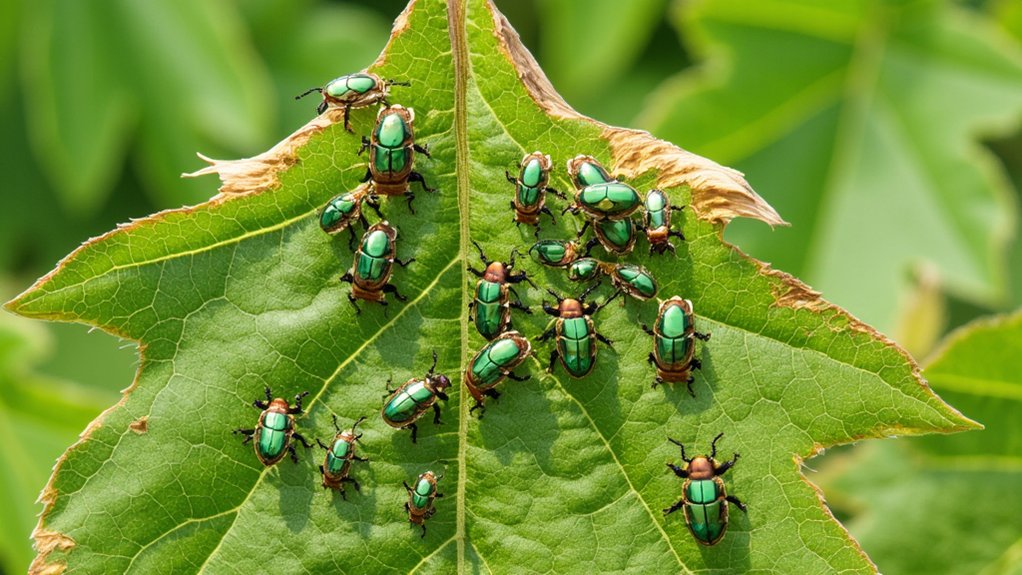
Since their accidental introduction to New Jersey in 1916, Japanese beetles have become one of North America’s most destructive tree pests. You’ll spot these metallic-green insects, measuring about 1/2 inch long, munching on tree leaves from June through August, leaving behind distinctive skeleton-like foliage.
These voracious feeders don’t discriminate – they’ll attack more than 300 plant species, but they’re particularly fond of linden, birch, and maple trees. You’ll often see them feeding in groups, starting at the top of trees and working their way down.
If you examine damaged leaves closely, you’ll notice they’ve been eaten between the veins, creating a lace-like pattern. The adult beetles are most active on warm, sunny days, and they’ll typically feed for 4-6 weeks before laying eggs in nearby soil.
Spider Mites on Houseplants
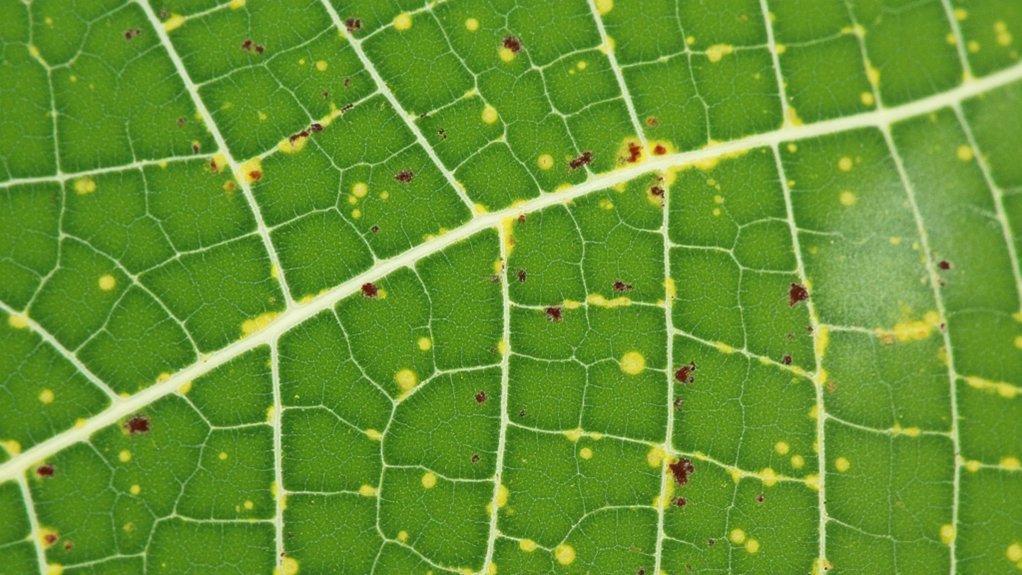
Despite their tiny size of just 1/50 inch, spider mites can wreak havoc on your cherished houseplants before you even notice them. You’ll first spot their damage as tiny yellow or white speckles on leaves, which eventually turn brown and fall off. These arachnids also spin fine webbing between leaves and stems, particularly visible when infestations become severe.
To check for spider mites, hold a white paper beneath suspicious leaves and tap them gently. If tiny moving dots fall onto the paper, you’ve got spider mites. They thrive in warm, dry conditions, multiplying rapidly when temperatures exceed 85°F. These pests are particularly fond of indoor palms, ficus trees, and ivy, often gathering on leaf undersides where they’ll pierce plant cells to feed.
Snails on Leafy Greens
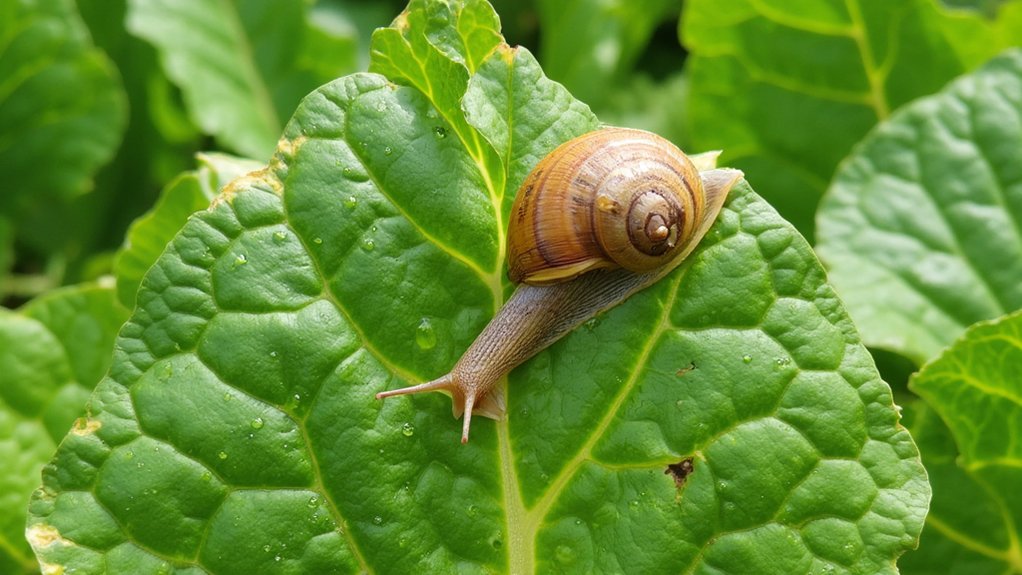
While snails move slowly across your garden, they can rapidly devastate leafy greens by chewing large, irregular holes through leaves and stems. You’ll notice their distinctive slime trails, which appear as silvery tracks across leaves and soil, particularly visible in early morning or evening hours.
To identify snail damage, look for ragged holes with smooth edges, typically 1/2 to 1 inch in diameter, scattered throughout your lettuce, kale, or Swiss chard. Unlike caterpillar damage, snail holes often extend from the leaf edges inward, and you won’t find droppings nearby.
These mollusks are most active at night and in damp conditions, hiding under leaves or garden debris during the day. They’re especially drawn to tender young plants, and you’ll frequently spot them after rainfall when temperatures range between 50-70°F.
Tomato Hornworms on Nightshades

Although tomato hornworms can be tricky to spot at first, you’ll recognize these large green caterpillars by their distinctive white V-shaped markings and rear horn-like projection. These destructive pests, which can grow up to 4 inches long, primarily feed on tomatoes, peppers, eggplants, and other nightshade family plants.
You’ll typically notice their presence when you see irregular holes in leaves and missing portions of fruit, often accompanied by black droppings on leaves below. They’re most active from July through September, feeding heavily at night while hiding along stem centers during daylight hours.
To locate these camouflaged creatures, inspect your plants’ upper portions where fresh damage appears, paying special attention to stems and the undersides of leaves. They’ll often position themselves parallel to plant stems, making them harder to detect against the green foliage.
Cutworms on Young Seedlings
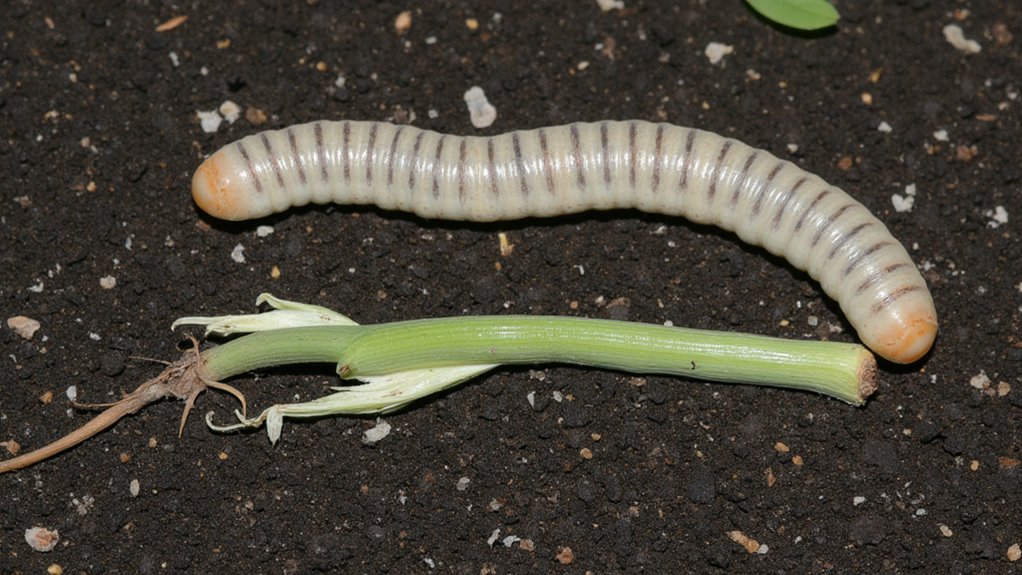
Another nocturnal menace in your garden, cutworms pose a particular threat to tender young plants. These grayish-brown, 1-2 inch caterpillars hide in the soil during daylight hours, emerging at night to feed on stems at ground level, often severing plants completely.
You’ll typically notice cutworm damage when your seedlings mysteriously collapse or disappear overnight. Look for clean cuts through stems about 1-2 inches above soil level, and small holes or droppings near affected plants.
To identify these pests directly, carefully dig 1-2 inches into the soil near damaged plants during early morning hours. You’ll find cutworms curled into a distinctive C-shape, often blending with soil particles. They’re most active in spring, targeting seedlings less than 4 weeks old, particularly brassicas and leafy greens.
Whiteflies on Ornamental Flowers
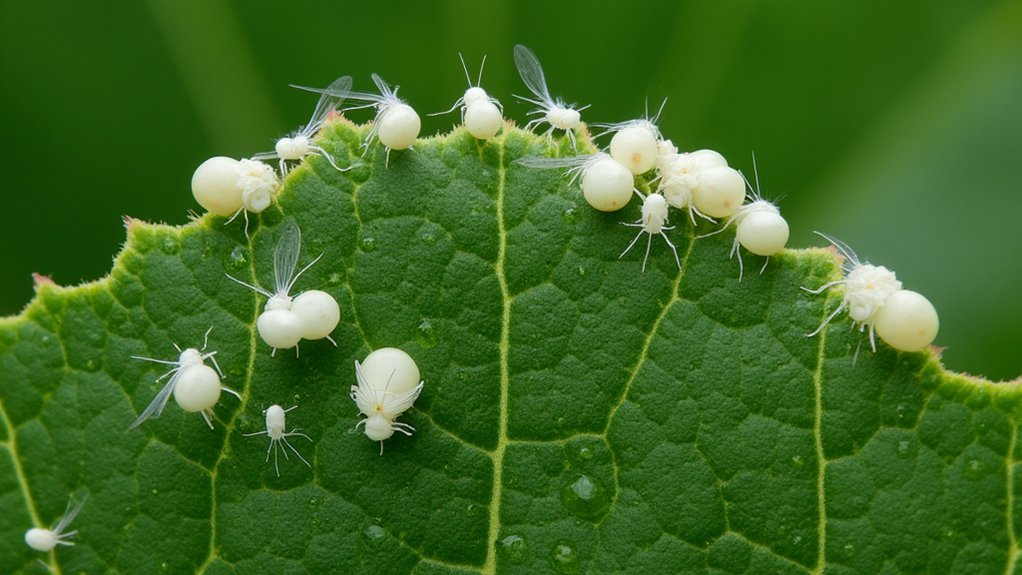
Once you spot tiny white insects fluttering around your prized ornamental flowers, you’re likely dealing with whiteflies. These 1/16-inch pests cluster on the undersides of leaves, where they feed on plant sap and multiply rapidly in warm conditions.
You’ll notice whiteflies when you brush against affected plants, as they’ll quickly disperse into the air before settling back down. The insects leave behind a sticky substance called honeydew, which can lead to black sooty mold growth on your flowers.
Check for early signs by examining leaf undersides during morning hours, when whiteflies are less active. You’ll often find them on popular ornamentals like hibiscus, poinsettias, and gardenias. Their eggs appear as tiny oval shapes in spiral patterns, while nymphs look like flat, pale ovals attached to leaves.
Squash Bugs on Pumpkin Vines
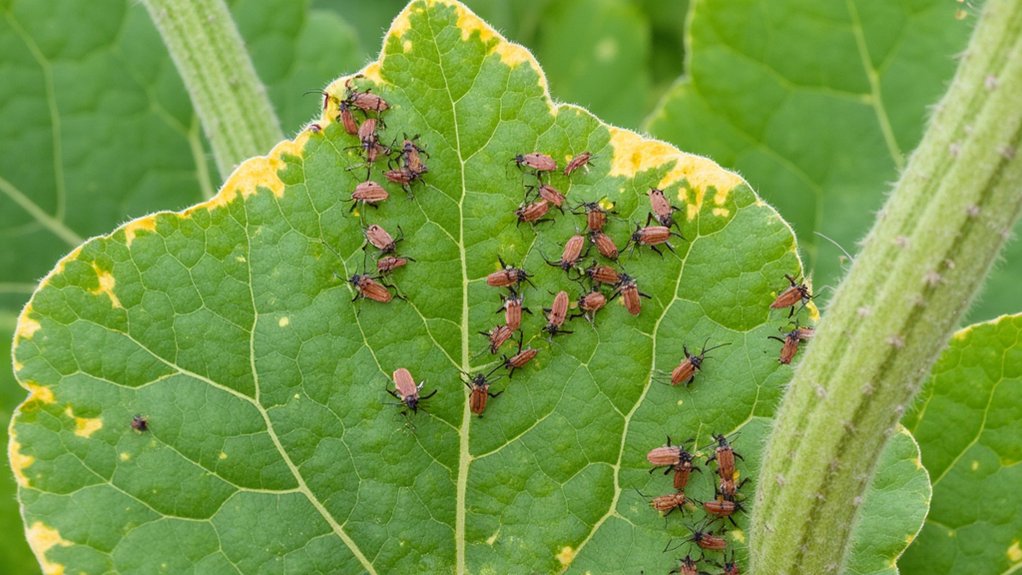
When pumpkin vines show signs of wilting leaves and discoloration, you’re likely facing an invasion of squash bugs. These shield-shaped pests, measuring about 5/8 inch long, are grayish-brown with flat backs and distinctively banded edges along their abdomens.
You’ll typically find these insects clustering on the undersides of leaves or near the vine’s base, where they pierce plant tissue to extract sap. Adult squash bugs lay small, copper-colored eggs in neat rows, usually in groups of 15-20, which hatch within 10 days.
Check your vines early in the morning when squash bugs are less active. They’re easiest to spot on stems and leaf undersides, where you’ll notice their characteristic black droppings. If you find them, remove affected leaves and handpick any visible bugs before they multiply.
Earwigs on Strawberry Plants

Despite their intimidating appearance with prominent pincers, earwigs primarily damage strawberry plants during nighttime feeding frenzies. You’ll notice their presence by the irregular holes, about 1/4 inch in diameter, scattered across your ripening berries and tender leaves. These nocturnal pests often hide within 2-3 inches of the soil surface during daylight hours.
To confirm an earwig infestation, place rolled newspaper tubes near your strawberry plants at dusk. Check the tubes the next morning, and you’re likely to find these 1/2 to 3/4-inch-long, reddish-brown insects nestled inside. They’re particularly active during humid weather and can quickly multiply, with females laying 20-50 eggs every 3-4 weeks throughout the growing season.
Look for their distinctive droppings, which appear as tiny black specks near damaged areas of your plants.
